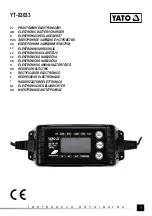
7
7.1. Fault Display
In case of a fault, one of the corresponding fault codes listed below will
appear on the display. If it is a critical fault, charging will stop and the red
Fault LED will be illuminated.
6.2.4. Status
6.2.4.1.
This menu displays the status of the charger’s internal
counters (number of normal and partial charges, fault
code, etc.).
6.2.4.2.
Status screen
6. Menu and Display Information (cont.)
7. Service and Troubleshooting
Memo
Description
Memo
Description
S/N
Wi-iQ
®
battery
monitoring device
serial number
I end
Current at end of charge
Capacity
Rated battery
capacity (Ah)
Temp end
Battery temperature
at end of charge (F)
U batt
Rated battery
voltage (V)
Chg Time
Time of the charge cycle
(minutes)
Temp
Battery temperature
at start of charge (F)
Ah
Amp-hours returned
during charge cycle
Techno
Battery technology
kWh
Kilowatt-hours returned
during charge cycle
Profile
Selected profile
Status
Partial or Complete
% init
State of charge at
start of charge (%)
Default
Fault codes
U start
Battery voltage at
start of charge (Vpc)
SoC
Start of charge date
and time
U end
Battery voltage at
end of charge (Vpc)
DBa
Battery disconnect
date and time
Warning
Wi-iQ
®
battery
monitoring device
warnings
CFC
Termination code
(for service tech)
Parameter
Description
Date/Time
Sets date and time of the charger. The clock has
a battery backup which will preserve the time
when power to the charger is off.
Language
Selects the language displayed in the menus.
Region
Selects the format for date, metric (EU) or imperial
(US) units for temperature, length and cable gauge
in both metric and AWG.
Display
Set screen saver function and display Themes.
Screen Saver
Enables or Disables the screen saver function.
Delay Savings
Set the time the screen stays illuminated. The delay
time is adjustable in minutes up to one hour and 59
minutes.
Themes
Themes A and B are two different ways that
information is displayed throughout the charge
cycle as seen in table below. Theme A is selected
by default and will be used in this manual.
Daylight Savings
Enables or disables automatic clock adjustment
for daylight savings time. When enabled, time
will move ahead one hour at 02:00 on the second
Sunday in March and will move back one hour at
02:00 on the first Sunday of November. The charger
must be powered up at the time of the change for it
to take effect.
Status
Description
Charge
Total number of charges - corresponds to the total of
normally terminated charges and charges terminated with
or by faults
Complete
Number of charges normally terminated
Partial
Number of charges terminated abnormally
TH
Number of charger temperature faults
DF1 etc.
Number of faults recorded by the charger (see Fault Codes)
6.3. Setting parameters
6.4. USB
6.4.1.
This menu provides access to the USB function to update software.
6.4.2.
Software Updates are provided by EnerSys
®
.
6.5. Password
6.5.1.
This is where the password is entered to gain access to service level
menus by authorized EnerSys
®
service personnel.
7.2. Fault Codes
Error
Cause
Solution
DF-CUR
Current fault before DF1
(can be low mains, phase
missing or faulty module)
Call for Service
DF1
Critical current fault, all
modules are on DF1 fault
(check the mains and
phase missing)
Call for Service
DF2
Output fuse fault, battery
reverse polarity
Check the correct connection
of the battery (reversed polarity
cables) and the output fuse.
DF3
Incorrect Battery voltage
for charger setting
Too high or too low battery
voltage. Battery voltage must
be between 1.6V and 2.4V per cell
for Lead Acid technology.
Use proper charger for battery.
DF4
Overdischarge
Charge continues.
DF5
Battery or charger setting
inspection (Ah security,
charge timeout, negative
voltage Dv/Dt)
DF5 appears when the charging
profile has been achieved with
a fault condition, that can be a
current increase in regulation
phase demonstrating a battery
heating or a badly programmed
regulation voltage, or the
charging time is too long and has
exceeded the safety limit. Check
charging para meters: profile,
temperature, capacity, cables.
Check the battery (defective cells,
high temperature, water level).
DF7
Air pressure pump fault.
Current Di-Dt, thermal run
away.
Call for Service
TH
Charger Thermal fault, all
modules are on thermal
fault (check air flow, and
ambient temperature).
Verify the proper operation
of the fans and/or absence of too
high ambient temperature, or
there is poor natural ventilation
to the charger.
TH-Amb
Ambient temperature too
high
Move the charger in a place with
lower ambient temperature.
Follow instrucitons on installation
and safety
DFMOD
Module faulty (refer to
Module Menu to know
the fault type)
Call for Service
MOD DEF
Module is unplugged
or not answer
Clean the module or the
backplane connection. If not
working Call for Service
MOD DFC
Module Converter faulty,
the module can't output
the maximum current
(check the AC phases,
and AC fuse)
Check power supply.
6.2.3. Memorization Data


























